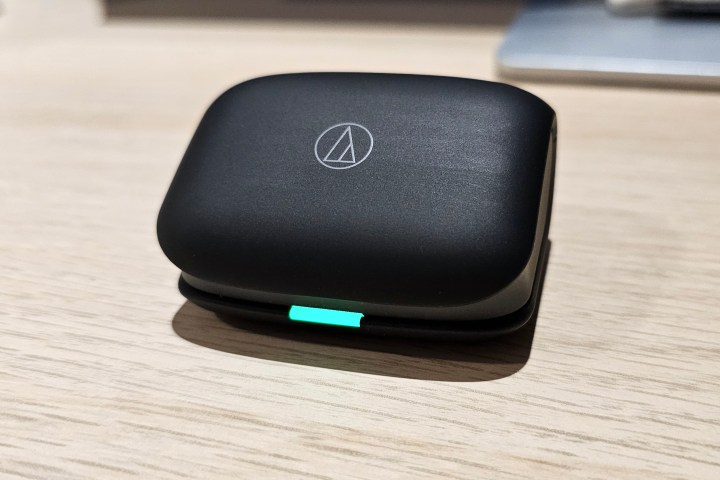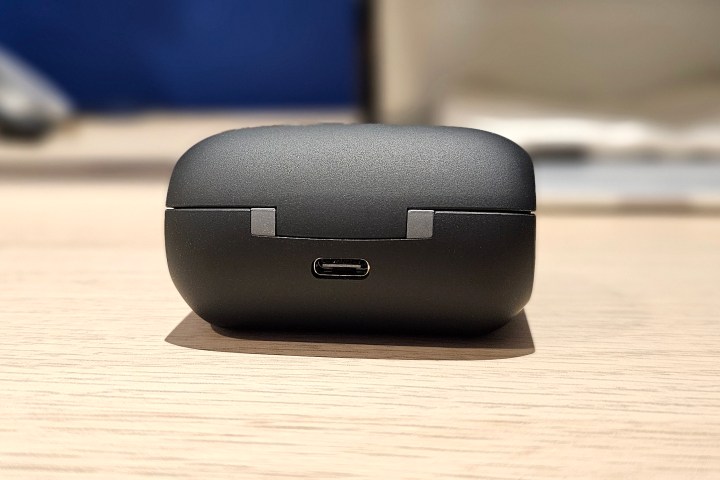Audio-Technica ATH-TWX7
MSRP $199.00
“Comfort, sound quality, and killer ANC should put the TWX7 on your shortlist.”
Pros
- Bold design
- Comfy and secure
- Intuitive, customizable controls
- Detailed sound
- Top-notch noise canceling
Cons
- Mediocre battery life
- No wear sensors
- Hard to hear your own voice clearly
When Audio-Technica (A-T) introduced its ATH-TWX9 wireless earbuds in 2023, I was impressed by their sound quality, design, and features. But it was their comfort and noise canceling that really stood out.
Unfortunately, so did the price. At $299, they’re among the more expensive options. It seemed to me then that A-T probably could put the best parts of the TWX9 in a set of earbuds that cost less. Apparently, A-T felt the same way. One year later, it debuted the ATH-TWX7 for $199.
The question is whether A-T made the right choices regarding which features to keep and which to omit. Now that I’ve had a few weeks to try them, I think the balance is almost perfect — especially if you’re picky about sound. Here’s my full take.
Audio-Technica ATH-TWX7: design
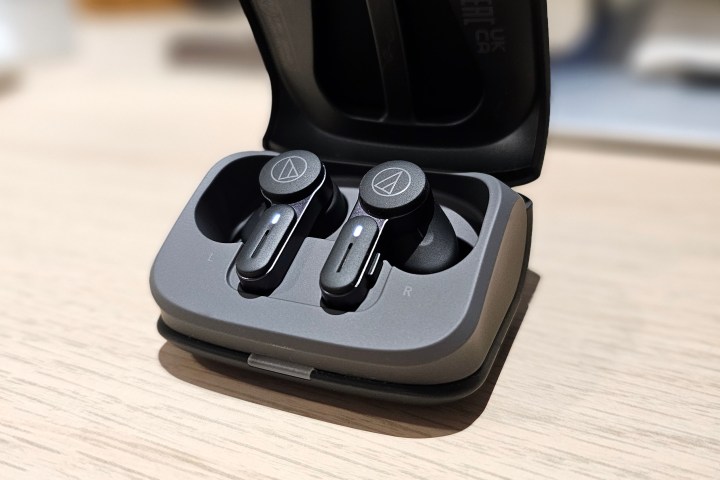
I really like the way the TWX7 look. A-T has chosen a mix of colors and finishes that make it appear as though the earbuds (which come in three color choices) are built on a metal housing. It’s a ruse but a convincing one. All the parts are, in fact, plastic.
Much like their flagship siblings, the ATH-TWX9, the TWX7 use a hybrid approach to their controls: A-T logos mark the touch-sensitive areas, while small physical buttons protrude from the leading edges of the stems.
The matte-finished charging case (which includes wireless charging in addition to USB-C) has an unusual, curved clamshell shape that might not be super pocket-friendly, but it does provide excellent access to the earbuds.
A large LED indicator on the front shows the case’s battery capacity, while smaller LEDs on each earbud show their respective capacities (this info is also available in the A-T Connect companion app). One note about the earbud LEDs: they flash once every 5 seconds while powered on, and there’s no way to disable that.
A-T says the buds are IPX4 rated, which means they can handle a splash of water here or there, and sweat shouldn’t be a problem at all as long as you wipe them clean after a workout.
Inside the box, you’ll find the buds in their case, a short USB-A-to-C charging cable, a cotton drawstring protective pouch, and a generous assortment of eartips.
Audio-Technica ATH-TWX7: comfort, controls, and connections

In general, I find stem-based earbuds to be more comfortable — but sometimes less secure — than stemless designs. The TWX7 seem to be one of the few exceptions. They feel great and hardly move at all. I found the same to be true with the TWX9, and thankfully A-T has given the TWX7 the same ergonomic shape.
It also helps that A-T includes two types of eartips (soft and firm) with four sizes each — an unusually large collection, even with earbuds that cost substantially more.
I’m equally enthusiastic about the controls. They’re very responsive (especially the tactile buttons), and while it may seem complicated or even confusing, having both buttons and touch controls is remarkably intuitive. By default, the touch panels are used for hearing-related functions such as active noise cancellation (ANC), transparency, and talk-through mode. They also let you trigger your voice assistant. The buttons are for playback, volume, and call management.
However, you can change all of them inside the A-T Connect app, including disabling the touch controls if you find they’re more annoying than helpful. This is way more choice than you’ll get in the TWX9 — those earbuds are Amazon Alexa-enabled, which typically results in a restricted level of control customization.
Sadly, A-T hasn’t preserved the TWX9’s wear sensors in the TWX7, so there’s no auto-pause when you remove a bud.
Speaking of the app, it lets you enable Bluetooth Multipoint to connect to two simultaneous devices. Better yet, it gives you a dedicated screen for managing these devices — you can memorize several and then select which two you want to be active. The screen also lets you add additional devices by pushing the earbuds into pairing mode — no physical button presses needed.
Audio-Technica ATH-TWX7: sound quality

Overall, the TWX7 sound great. While A-T’s studio headphones — like the popular ATH-M50x — are noted for their flat response, the company’s earbuds tend to deliver a bit more boost, particularly in the lower frequencies. It lends extra punch to a track like Billie Eilish’s bad guy, without overwhelming the mids or highs Eilish’s whispery vocals are still capable of eliciting an ASMR-like response.
I enjoy that default sound signature; it worked well with every genre I tried. But if you prefer a different balance, the A-T Connect app has a full equalizer with presets and custom settings.
The soundstage is generous, which can help create a deeper sense of immersion, particularly if you like listening to Dolby Atmos Music tracks.
There is one catch, however. A-T has used a very low level of amplification on the TWX7. So low that 50% volume — a standard on which most companies base their battery-life expectations — is quiet to the point of being useless for enjoyable listening.
In fact, I was able to crank the earbuds to 95% volume without experiencing any discomfort, which is highly unusual.
The TWX7 use the same 5.8mm drivers as the pricier TWX9, and both models are hi-res audio capable. I was fully expecting them to sound more or less the same when paired with Android phones that support the relevant hi-res Bluetooth codecs (Sony’s LDAC on the TWX7, Qualcomm’s aptX Adaptive on the TWX9). But that wasn’t the case.
It’s the first time I’ve been able to make a true direct comparison between these codecs (it’s rare for a company to issue nearly identical products that use different codecs), and the difference was stark: aptX Adaptive on the TWX9 sounded much better.
Moreover, when I forced my two Android test phones (Google Pixel 7 Pro and Motorola ThinkPhone) to use LDAC at its highest 990kbps setting, severe audio breakup set in, even at distances of less than one foot.
Audio-Technica ATH-TWX7: noise cancellation and transparency
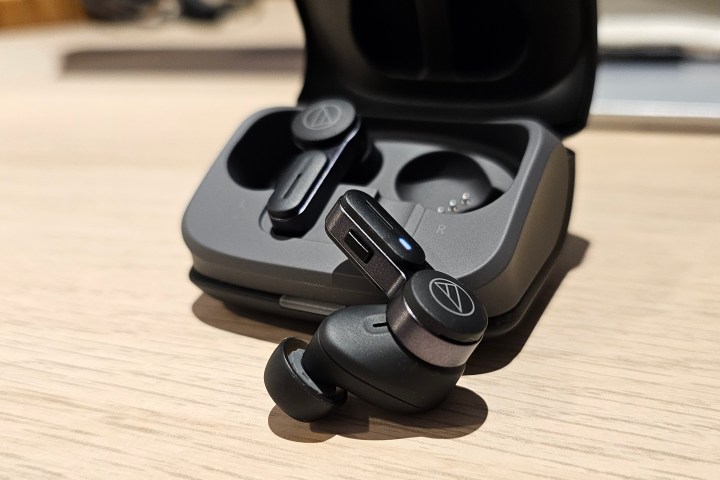
We’re quickly getting to the point where you don’t need to spend crazy money to get a great set of noise-canceling (ANC) earbuds, and the TWX7 are a great example. The ANC mode did a fantastic job of blocking out a wide variety of unwanted sounds, from traffic to sounds of background chatter in a coffee shop. It even handled some wind without needing to be shifted to a specific wind-noise mode.
I haven’t had a chance to do the classic airplane cabin test. But based on how well they handle other types of sounds, I’m very optimistic about it.
Transparency is also very good, but it’s targeted: you’ll be able to hear the most important sounds in your immediate surroundings (including people’s voices), but your own voice will remain quite muffled.
Within the A-T Connect app, you can choose whether to toggle between off, ANC on, and transparency modes, or just ANC and transparency.
There’s also a handy talk-through mode, which is essentially the transparency mode with automatic music volume reduction, saving you the need to pause your tunes or remove the earbuds.
Audio-Technica ATH-TWX7: call quality
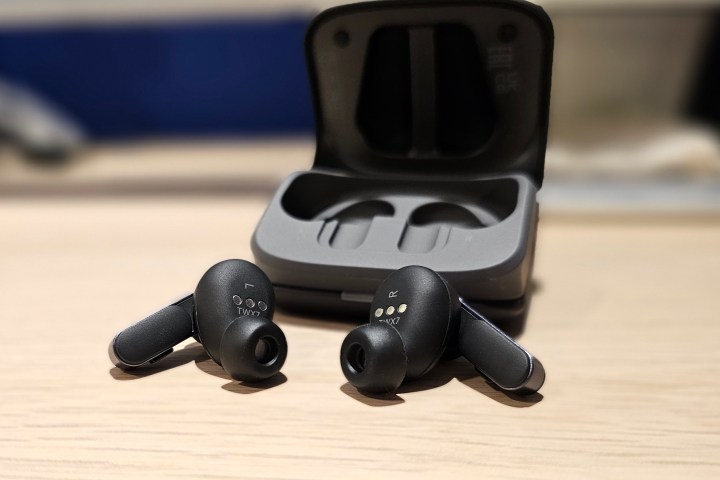
Calling on the ATH-TWX7 can be a very good experience for your callers, but you’ll need to select the right mode in the A-T Connect app. The so-called natural voice mode is great for indoors when there’s little to no background noise. However, it can’t compete with noisy and/or windy situations; there’s a noise-reduction mode for those moments.
I’m not thrilled by this — many other wireless earbuds at the same price or less can adapt automatically to different environments.
But my biggest gripe with calling on the TWX7 is the lack of a side-tone setting so that you can hear your voice more clearly. You can’t switch ANC modes during a call, but even if you could, transparency mode (as I mentioned above) doesn’t help much.
Audio-Technica ATH-TWX7: battery life
A-T claims you’ll get about 7.5 hours of playtime per charge on the TWX7 if you keep ANC turned off. That drops to 6.5 hours if you leave it on. When you include the charging case’s capacity, your total playtime will be 20 or 24 hours, respectively. Those numbers put the TWX7 in one of the lower battery life categories — about the same as the Apple AirPods Pro.
However, these numbers need to be considered best-case scenarios, and frankly not very easily achieved best-case scenarios.
Remember when I said I needed to pump the volume way higher than 50%? Listening at louder volumes will shave 30 to 45 minutes off these times. And if you want to take advantage of LDAC for hi-res audio, expect to pay a hefty tax. A-T doesn’t publish playtime numbers when using LDAC, but Technics does.
For the EAH-AZ80 earbuds, the difference is significant: Seven hours with ANC but no LDAC, and just 4.5 hours with ANC and LDAC.
A similar reduction (35%) on the TWX7 could mean as little as 4.3 hours when ANC and LDAC are used simultaneously.
With excellent comfort, great sound quality and noise cancellation, and a clever and sleek design that breaks the mold of typical wireless earbuds, the Audio-Technica ATH-TWX7 have a lot to recommend them.
While not perfect — battery life isn’t as strong as I’d like, and the lack of a true side-tone can make calling a fatiguing experience — they still compare very well to similarly priced models.
Sony’s LinkBuds S ($200), for instance, use the same LDAC hi-res codec and sound very good, have very good noise-canceling and (since a firmware update) support Bluetooth multipoint. They also have wear sensors, which the TWX7 lacks, but they don’t have a wirelessly charging case.
For those who want all the bells and whistles, including better sound quality when paired with an aptX Adaptive Android phone, the more expensive ATH-TWX9 might be worth the extra $100.
Editors’ Recommendations


